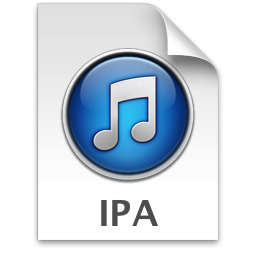|
The iPhone Wiki is no longer updated. Visit this article on The Apple Wiki for current information. |
Difference between revisions of "IPA File Format"
m (removing duplicate content I forgot to remove...) |
m |
||
| Line 1: | Line 1: | ||
| − | [[Image:IPAFile.png|thumb|IPA file icon from [[iTunes]] 11 |
+ | [[Image:IPAFile.png|thumb|IPA file icon from ''[[iTunes]] 11'']] |
| − | A '''IPA''' archive is the de facto way to package applications for [[iOS]]. The |
+ | A '''IPA''' archive is the de facto way to package applications for [[iOS]]. The extension has no official definition, but is commonly called ''iPhone Application'' by the [[iOS]] community. The file is just a renamed [[wikipedia:zip (file format)|ZIP]] archive. Although any computer with a ZIP archive reader can extract an IPA, [[wikipedia:Portable Network Graphics|PNG]] images (e.g. the app's icon files) are typically in a [[Apple PNG|proprietary variant of the PNG format]] instead of the standardized PNG format, and the application binary is encrypted ([[wikipedia:Digital rights management|DRM]]) which hinders the ability to examine the binary. |
== Contents == |
== Contents == |
||
| Line 18: | Line 18: | ||
# Build application |
# Build application |
||
# Locate the <code>.app</code> folder |
# Locate the <code>.app</code> folder |
||
| + | # Create a folder named <code>Payload</code> |
||
| − | Create a root folder, inside this folder create another folder called 'Payload' and place your application in here. Next, create a 512x512 image for your icon, call it iTunesArtwork and place it in the root folder. Create an [[iTunesMetadata.plist]] file and place it in the root folder as well. ZIP the contents of the root folder and not the root folder itself, i.e. select the items inside the root folder and '''not''' the root folder itself. Use the following ZIP command to properly create IPA files; |
||
| + | # Place your <code>.app</code> folder in it |
||
| − | zip -u -y -r -n .jpg:.JPG:.jpeg:.png:.PNG:.gif:.GIF:.Z:.gz:.zip:.zoo:.arc:.lzh:.rar:.arj:.mp3:.mp4:.m4a:.m4v:.ogg:.ogv:.avi:.flac:.aac ''IPAFileName.ipa'' ''./*'' |
||
| + | # Create a 512x512 JPEG version of your icon |
||
| + | # Save it as <code>iTunesArtwork</code> (no extension) |
||
| + | # Create your <code>[[iTunesMetadata.plist]]</code> and save it |
||
| + | # "ZIP" the contents |
||
| + | #* <code>iTunesArtwork</code> |
||
| + | #* <code>[[iTunesMetadata.plist]]</code> |
||
| + | #* <code>Payload/</code> |
||
| + | |||
| + | [[Category:File Formats]] |
||
Revision as of 00:04, 22 March 2013

A IPA archive is the de facto way to package applications for iOS. The extension has no official definition, but is commonly called iPhone Application by the iOS community. The file is just a renamed ZIP archive. Although any computer with a ZIP archive reader can extract an IPA, PNG images (e.g. the app's icon files) are typically in a proprietary variant of the PNG format instead of the standardized PNG format, and the application binary is encrypted (DRM) which hinders the ability to examine the binary.
Contents
As an IPA file is just a renamed ZIP archive, its structure is available from PKWARE.
- iTunesArtwork
- iTunesMetadata.plist
- Payload/
- ApplicationName.app/
- (various application files)
- ApplicationName.app/
Usage
Apple uses the IPA format for packaging iOS aplications. iTunes can be used to install their contents on a device, provided the included files are signed. Developers can use the IPA format for Ad Hoc Distribution of their apps.
Creation
IPA files are typically created through Xcode, but may be created manually:
- Build application
- Locate the
.appfolder - Create a folder named
Payload - Place your
.appfolder in it - Create a 512x512 JPEG version of your icon
- Save it as
iTunesArtwork(no extension) - Create your
iTunesMetadata.plistand save it - "ZIP" the contents
iTunesArtworkiTunesMetadata.plistPayload/